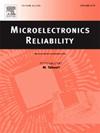汽车led的疲劳损伤:实验方法和热力学模型
IF 1.9
4区 工程技术
Q3 ENGINEERING, ELECTRICAL & ELECTRONIC
引用次数: 0
摘要
汽车照明行业继续经历着显著的增长,因为它拥抱了专注于更高性能和更智能功能的新趋势。汽车领域的任何新产品都必须经过严格的加速试验,以确保其在使用寿命期间可能遇到的各种条件下的可靠性。由于LED封装与PCB基板之间的热膨胀系数不匹配,导致焊点疲劳失效是加速热循环过程中的主要失效模式之一。本文着重分析了三种led (2-pad, 3-pad和4-pad)配置,并进行了热循环测试。首先,在不同的循环阶段观察染料渗透在测试过程中的焊点损伤。在测试过程中,监测ΔVF的变化,以跟踪LED作为循环函数的性能演变。分析了染料渗透观察,以跟踪损伤的演变。在2-pad、3-pad和4-pad三种配置下,定义了损伤随ΔVF函数的预测模型,并建立了损伤规律。第二部分的重点是在IMS PCB上安装的3种led配置的热循环过程中,焊料SAC305接头上的应变的热力学建模。最后,在热循环测试中,对三种led配置的失效时间进行了疲劳分析。对三种结构进行了比较,并与试验结果进行了相关性分析,以评价预测的准确性。本文章由计算机程序翻译,如有差异,请以英文原文为准。
Fatigue damage of automotive LEDs: Experimental approach and thermomechanical model
The automotive lighting industry continues to experience significant growth as it embraces new trends focused on higher performance and smarter functionalities.
Any new products in automotive must undergo severe accelerated tests in order to ensure its reliability under the various conditions that it may be confronted with during its lifetime.
Due to the coefficient of thermal expansion mismatch between the LED package and the PCB substrate, the solder joint fatigue failure was revealed to be one of the major failure modes during accelerated thermal cycling.
The present work focuses on analyzing three LEDs (2-pads, 3-pads and 4-pads) configurations subject to thermal cycling test. First, the damage in the solder joints during tests is observed with dye penetration at different stages of cycling. During the tests, monitoring of the variation of ΔVF was made to follow the performance evolution of LED as a function of cycles. The dye penetration observations were analyzed to follow the evolution of the damage. On the 3 configurations of LEDs (2-pads, 3-pads and 4-pads) a model predicting the damage as function of the ΔVF was defined and used to establish a damage law.
The second part is focusing on a thermomechanical modeling of the strains on the solder SAC305 joint occurring during thermal cycles for the 3 configurations of LEDs mounted on the type of IMS PCB.
Finally, a fatigue analysis is addressed based on the 3 configurations of LEDs on the time to failure in the thermal cycle test. A comparison between three configurations is made and a correlation with test results is performed to evaluate the accuracy of the prediction.
求助全文
通过发布文献求助,成功后即可免费获取论文全文。
去求助
来源期刊

Microelectronics Reliability
工程技术-工程:电子与电气
CiteScore
3.30
自引率
12.50%
发文量
342
审稿时长
68 days
期刊介绍:
Microelectronics Reliability, is dedicated to disseminating the latest research results and related information on the reliability of microelectronic devices, circuits and systems, from materials, process and manufacturing, to design, testing and operation. The coverage of the journal includes the following topics: measurement, understanding and analysis; evaluation and prediction; modelling and simulation; methodologies and mitigation. Papers which combine reliability with other important areas of microelectronics engineering, such as design, fabrication, integration, testing, and field operation will also be welcome, and practical papers reporting case studies in the field and specific application domains are particularly encouraged.
Most accepted papers will be published as Research Papers, describing significant advances and completed work. Papers reviewing important developing topics of general interest may be accepted for publication as Review Papers. Urgent communications of a more preliminary nature and short reports on completed practical work of current interest may be considered for publication as Research Notes. All contributions are subject to peer review by leading experts in the field.
 求助内容:
求助内容: 应助结果提醒方式:
应助结果提醒方式:


